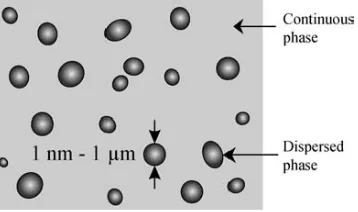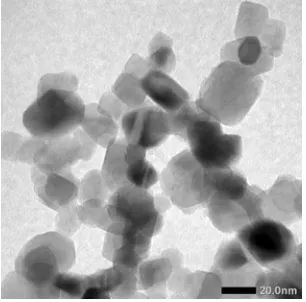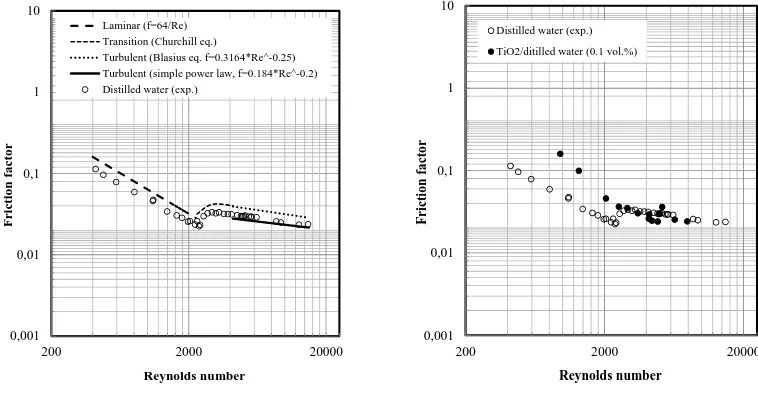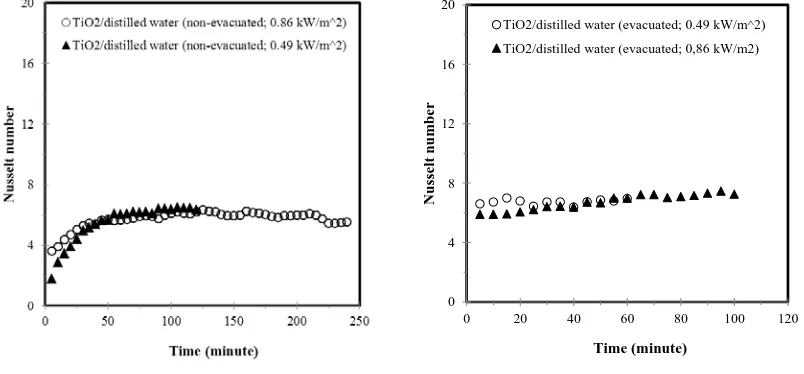UTILIZATION OF NANOFLUIDS POTENCY AS ADVANCED HTFs
ON SOLAR PARABOLIC TROUGH COLLECTOR
EVACUATED TUBE RECEIVER
Budi Kristiawan
1, Eko Prasetya Budiana
1, Endah Retno Dyartanti
21
Mechanical Department, Faculty of Engineering, Sebelas Maret University Jl. Ir. Sutami 36A Kentingan Surakarta 57126 Telp. 0271 632163
2
Chemical Department, Faculty of Engineering, Sebelas Maret University Jl. Ir. Sutami 36A Kentingan Surakarta 57126 Telp. 0271 632112
Email: [email protected]
Abstract
An experimental investigation has been performed to study thermal performance of TiO2/distilled water nanofluid in an evacuated tube receiver model with titania nanoparticles concentration of 0.1 vol.%. In the solar parabolic trough collector system, an evacuated tube receiver usually is employed to efficiently absorb the radiation reflection from the parabolic collector. In the present work, the uniform heat flux is generated by variac transformer for a fix magnitude instead of daily solar radiation. The results of this investigation show that the applied heat flux has just affected on outlet temperature of nanofluids but it does not influence on dimensionless number (Nusselt number). The result also indicates that the friction factor of the observed nanofluid is higher than that of the base fluid. For thermal performance, the average Nusselt number enhancement between non-evacuated and evacuated condition yields 17.9% and 21.7% for water and nanofluid, respectively. Due mainly to adding nanoparticles into base fluid, the changes of the thermophysical properties of nanofluid and thermal boundary layer at the inside pipe wall play an important role in heat transfer enhancement. With applying an evacuated condition application into receiver tube, thermal performance of Nano fluids is more efficient than that of non-evacuated condition.
Keywords: evacuated tube; nanofluid; solar PTC; thermal performance; titania
Introduction
A solar parabolic trough collector (solar PTC) is a special design of heat transfer in which solar radiation energy is converted into heat through a receiver or heat collecting element (HCE). This receiver has a smaller surface area to minimize heat loss compared with flat plat collector. A polished metal mirror is usually used as the parabolic collector to concentrate solar beam. A linear parabolic concentrating serves as a reflector which reflects solar beam and a tube receiver as well as will absorb its reflection. This optic linear system will focus directly beam to a straight tube receiver. Hence, both a straight evacuated tube receiver and a curved parabola with a polished metal mirror play a necessary role in solar radiation absorption. The incident radiation that enters the parabolic mirror is focused along focal point in which a tube receiver is placed to be heated. An evacuated tube receiver of the solar PTC is located at the focus line of the reflective parabolic surface with means of transferring the absorbed solar energy to the specific heat transfer fluids. The outer surface of the tube receiver is coated with selective blacked nickel to effectively absorb and the tube receiver is covered with glass tube to create an annulus gap. This annulus gap is vacuumed in order to reduce conduction and convection between tube receiver and glass envelope. In the solar PTC, the radiant energy is transferred to the heat transfer fluids in a far enough distance. This typical solar collector can be utilized for practical application requiring energy delivery at medium or high temperature up to 300°C above ambient temperature (Duffie and Beckman, 2005).
thermal conductivity of liquids by adding millimeter- or micrometer-sized solid particle in a host fluid have been begun by many researchers more than a century ago. Numerous theoretical and experimental studies on the effective thermal conductivity of suspensions have been conducted. Due to lack of these suspensions stability is reasonable to avoid these suspensions as heat transfer working fluid. The large size and high density of the solid particles induce agglomeration of suspensions which will produce significantly additional flow resistance and possible erosion in tubes. Therefore, the application of these suspensions to enhance thermal conductivity and heat transfer performance was tremendous limited.
In the solar parabolic trough collector, the heat collecting element plays a notable role which converts solar radiation into heat and transfers it to the HTFs flowing through the tube (Lüpfert et al., 2008). On the other hand, the HTFs and heat loss greatly affect in the large parabolic collector performance. The thermophysical properties in particular thermal conductivity of these HTFs play a very important role in the development of energy-efficient heat transfer system. However, conventional HTFs such as water, ethylene glycol, propylene glycol, and engine oil, have inherently poor thermal conductivity properties compared to most solids. The primary problem using solid particles of milli or micrometer to alter heat transfer is that they highly settle rapidly in liquids. This suspension also cause abrasion, clogging, and additional pressure drop. To overcome these problems, nanoparticles are employed in a dispersion instead of milli or microparticles called nanofluids. The nanofluids term was first introduced by Choi (1995) defined as dispersing nanoparticles (normally below 100 nm) into conventional HTFs. Nanofluids are categorized as dispersed a colloid by a few researchers. Colloidal system are a dispersion system in which one phase has dimensions in order of 1 nm to 1 µm (Butt and Kappl, 2010) as schematically shown in Figure 1. Taylor et al. (2011) have experimentally characterized optical property of nanofluid towards efficient direct absorption solar collectors. Due to considerable complex of dispersed colloids or nanofluids morphology, correlation of nanofluids convection heat transfer coefficient has not much been developed. Nanofluids might be reasonable to treat them as pure liquids and Newtonian fluids on account of the tremendous small size and the low volume fraction of the nanoparticles in the most conventional HTFs.
Figure 1. Schematic of a colloidal dispersion.
Unlike suspensions containing coarse particles, nanofluids contain the dispersed ultrafine powder with low volume fraction. The considerable small size and large specific surface area of nanoparticles not only enhance the stability of dispersions but also improve heat transfer performance significantly. Hence, the investigations with regard to the preparation and the thermal conductivity of stable nanofluids have been being explored experimentally by a few researchers for over two decades. Recently, Kristiawan et al. (2012) have conducted experimentally thermal conductivity enhancement for TiO2/EG and Al2O3/EG nanofluids with increasing volume fraction of 1.0 to
2.5 wt.%. However, the mechanism of the enhancing thermal conductivity in nanofluids is still not obvious. The influences of several factors on the convection heat transfer coefficient, such as particles size, particles shape, size distribution, dispersants or surfactants, interfacial properties are still debated by many researchers. The reported data with respect to the mechanism of the thermal conductivity enhancement in nanofluids are inconsistent. Therefore, the experimental studies on preparation, characterization and thermal conductivity in nanofluids become the great challenges to develop the advanced HTFs.
In the present work, nanofluid is performed in the heat collecting element to analyze its potency as advanced HTFs. The TiO2/water nanofluid is used as HTFs in the evacuated receiver tube. The influence of heat flux
Material and Method Nanoparticles Characterization
The ultra-fine oxide nanoparticle used in this study was titania (TiO2- powder) nanopowder, ~21 nm particle
size, 99.7% trace metals basis procured from Sigma-Aldrich USA. In the Figure 2, the transmission electron microscopy photograph of titania using the JEOL JEM-1400 is depicted. This testing is a standardized method for imaging and measurements of dimension of nano and micro sized structures due to their high imaging speed and high resolution According to the image, the samples of titania nanoparticles mainly consist of nearly solid particles with nominal diameter of 21 nm. Furthermore, the x-ray diffractometer using the Lab X XRD-6000 Shimadzu was employed to identify the crystal phase of the oxide nanoparticle as described in Figure 3. According to comparison the JCPDS-International Centre for Diffraction Data, titania indicated an anatase mineral. These patterns have been found that the oxide nanoparticles used in the experimental study were single-phase nanoparticles with tetragonal structure.
Figure 2. The TEM image of titania nanoparticles
0 300 600 900 1200 1500
0 10 20 30 40 50 60 70 80 90
In
te
n
si
ty
(c
o
u
n
ts
)
2theta (deg)
Figure 3.The XRD patterns of titania nanoparticles
Nanofluid Preparation
Figure 4. The sample of TiO2/distilled water nanofluid.
Experimental Setup
An experimental setup was established based on schematically diagram as shown in Figure 5. The experimental apparatus consisted of an evacuated tube receiver, a heating unit, a cooling system, a flow controlling unit, and a measuring unit. A home-made evacuated tube receiver that consist of copper tube and glass cover was employed as the test section. A copper tube with 11.5 mm outer diameter and 12 mm inner diameter were used. Meanwhile, a glass envelope with 81 mm outer diameter was utilized to cover a copper tube in order to forming a annulus tube. A pressure gage was mounted at the end of the test section to indicate on an evacuated condition up to 60 kg/cm2 under atmosphere pressure. A control valve was used to create and to release of vacuum pressure. A gear pump with applying speed reducer was used to circulate the nanofluid through the evacuated tube from the collecting reservoir in the present work. The flow rate was measured by a weighing machine in period of time using stopwatch. To measure the pressure drop, two piezometer tubes were used in this present experiment in consequence of highly small pressure drop. To generate an uniform heat flux instead of solar radiation, a nichrome wire was used as an electric heater in the laboratory scale work. The variac transformer with a maximum capacity of 3 kW was connected to six nichrome wire coils which was wound on the outer wall of glass envelope. In order to reduce the heat loss, the coils were thermally insulated by glass wool and aluminum foil. In this study, five K-type thermocouples were mounted on the receiver tube at the axial position of 250 mm (Ts,1), 500 mm (Ts,2), 750 mm
(Ts,3), 1000 mm (Ts,4), and 1250 mm (Ts,5) from the inlet of test section. Meanwhile, two thermocouples were
inserted at the inlet and outlet of the test section to measure the bulk temperature of the nanofluid. Data acquisition system connected to a PC unit was used to record the temperature readings from thermocouples in the real time with period of 5 minute.
Re
Thermophysical Properties of Nanofluid
Thermophysical properties of the observed nanofluids must be known prior to calculating the convective heat transfer coefficient. In this experimental work, temperature-dependent thermophysical properties of nanofluids such as, effective density, specific heat and thermal conductivity have been considered. These thermophysical properties of water-based nanofluids can be calculated using the established correlations proposed by previous studies. The effective density and specific heat of nanofluids can be estimated as follows:
(1)
(2)
The effective thermal conductivity of nanofluids correlated by Patel et al. (2010) is used to predict its value defined as:
(3)
Data Reduction
Due to assuming the constant radiation, convective heat transfer experiments were carried out under an uniform wall heat flux boundary (UWHF) conditions. The generated wall heat flux can be determined from the sensible heat gain by the flowing nanofluid,
(4)
The average heat transfer coefficient can be calculated as follows,
(5)
where the observed nanofluids properties are evaluated at the bulk temperature,
(6)
WhereTw,iis the average inner wall temperature calculated from local wall temperature,
(7)
The average Nusselt number is defined as,
(8)
It is noted that all thermophysical properties of the test nanofluids are determined based on a mean bulk temperature.
Result and Discussion Friction Factor
Preliminary experiments were performed on pure water in order to validate the experimental setup for friction factor. Friction factors were validated with the established correlation for laminar, transition, and turbulent flow such as, Hagen-Poiseuille, Churchill, and Blasius equation, respectively which are given as:
5
According to calculating of those equations, comparison between theoretical and experimental friction factor of distilled water flowing in a tube at adiabatic condition is depicted in Figure 3. It can be observed that friction factors of experimental data are in good agreement with theoretical values (Fig. 6.a). In Figure 6.b, the increasing of friction factor in TiO2/distilled water compared to that of the base fluid is clearly shown. Due to adding particles into
base fluid, the higher friction between the flowing nanofluid and pipe wall is occurred. The high friction factor augmentation induces extra penalty in pumping power thus it must be considered in thermal system design of nanofluid applications. Turbulent (simple power law, f=0.184*Re^-0.2) Distilled water (exp.)
Figure 6. Variation of experimental friction factor with Reynolds number.
The Effect of Heat Transfer Fluids
In this experimental investigation, the different heat transfer fluids such as the base fluid (water) and the TiO2/distilled water nanofluids are performed with heat flux of 0.86 kW/m2 and the volumetric rate of 0.35 LPM. It
is noted that all experiments are analyzed with temperature-dependent properties of the heat transfer fluids. The effect on their heat transfer performance is shown in Figure 6. For the base fluid (6.a), there is insignificant Nusselt number change for both non-evacuated and evacuated conditions. However, the evacuated condition in receiver tube shows the higher thermal performance compared with non-evacuated condition for TiO2/distilled water nanofluid
0 4 8 12 16 20
0 50 100 150 200 250
N
u
ss
elt number
Time (minute)
Water (Non evacuated) Water (Evacuated)
0 4 8 12 16 20
0 50 100 150 200 250
N
u
ss
elt number
Time (minute)
TiO2/ditilled water (Non evacuated) TiO2/distilled water (Evacuated)
a.Base fluid (water) b. TiO2/distilled water nanofluid
Figure 6. Comparison between water and TiO2/distilled water for the Nusselt number in the real-time.
The Effect of Heat Flux Magnitude
Figure 7 presents the effect of the generated heat flux magnitude on Nusselt number in which the heat flux used in this work are 0.49 and 0.86 kW/m2. The volumetric rate flowing into receiver tube in all experiments is 0.35 LPM with Reynolds number of 800+50. Different heat flux magnitude applied into receiver tube indicates insignificant change of dimensionless number for both non-evacuated (7.a) and evacuated condition (7.b). The heat flux magnitude has just affected on outlet temperature of nanofluids. The higher heat flux magnitude, the higher outlet temperature. Therefore, Nusselt number does not be affected by the various solar energy magnitude in daily incident radiation. TiO2/distilled water nanofluid tends to constant value with increasing of time radiation for all
applied conditions. In the non-evacuated condition, Nusselt numbers dramatically increase for several hours until they achieve constant Nusselt number value. Conversely, Nusselt numbers have a constant trend from starting time up to achieving constant values in evacuated condition. It indicates that an evacuated condition into receiver tube is more efficient than that of non-evacuated condition.
0 4 8 12 16 20
0 20 40 60 80 100 120
Nu
ss
el
t nu
m
b
er
Time (minute)
TiO2/distilled water (evacuated; 0.49 kW/m^2) TiO2/distilled water (evacuated; 0,86 kW/m2)
a. Non-evacuated condition b. Evacuated condition
Conclusion
An experimental investigation has been conducted to study the nanofluids potency in an evacuated tube receiver. The results of this investigation show that the applied uniform heat flux has just affected on outlet temperature of nanofluids but it does not influence on dimensionless number (Nusselt number). The friction factor of TiO2/distilled water nanofluid is higher than that of the base fluid. The friction factor increasing of the test fluid
induces extra penalty in pumping power thus it must be considered in thermal system applications of nanofluid. For water and the nanofluid, the heat transfer enhancement between non-evacuated and evacuated condition are 17.9% and 21.7%, respectively. The thermophysical properties of nanofluid that change due mainly to adding nanoparticles into base fluid are responsible to heat transfer enhancement. According to applying different condition, the result of this research that an evacuated condition into receiver tube is more efficient than that of non-evacuated condition. In-depth investigations of nanofluid application on an evacuated tube receiver are still highly required in the future for practical and economical applications.
Acknowledgement
This present work was supported by the Directorate of Research and Community Service (DP2M) of Directorate General of Higher Education (DIKTI) and Institute for Research and Community Service (LPPM) of Sebelas Maret University Surakarta under grant No. 159a/UN27.11/PN/2013.
Nomenclature
T = temperature, °C cp = specific heat, kJ/(kg.K)
k = thermal conductivity, W/(m.K) d = nanoparticle diameter, m D = pipe diameter, m q′′ = heat flux, W/m2
m& = mass flow rate, kg/s Nu = Nusselt number
Re = Reynolds number Pr = Prandtl number Greek Symbols
φ = volume concentration
μ = absolute viscosity, N.s/m2
ρ = density, kg/m3
Subscripts nf = nanofluid np = nanoparticles References
Butt, H.J. and Kappl, M. , (2010), "Surface and Interfacial Forces", Third edition, WILEY-VCH Verlag GmbH & Co. KgaA Federal Republic of Germany.
Choi, S.U.S., (1995), "Enhancing Thermal Conductivity of Fluids with Nanoparticles, in Developments and Applications of Non-Newtonian Flows " D.A. Singer and H.P Wang, Eds., FED-231/MD-66, pp. 99-105. Duffie, J.A. and Beckman, W.A., (2005), "Solar Engineering of Thermal Processes", Third edition, John Wiley &
Sons, Inc.
Kristiawan, B., Kamal, S., Suhanan and Yanuar. (2012), "Modelling Thermal Conductivity Enhancement of Metallic Oxide-Based Nanofluids Using Dimensional Analysis" Seminar Nasional Tahunan Teknik Mesin XI (SNTTM XI) & Thermofluid IV Yogyakarta, 16-17 Oktober 2012. pp. 634-640.
Lüpfert, E., Riffelmann, K.J., Price, H., Burkholder, F. and Moss, T., (2008), "Experimental Analysis of Overall Thermal Properties of Parabolic Trough Receivers" Journal of Solar Energy Engineering, Vol. 130 pp. 1-7. Patel, H.E., Sundarajan, T. and Das, S.K., (2010), "An Experimental Investigation into the Thermal Conductivity
Enhancement in Oxide and Metallic Nanofluids" Journal of Nanoparticle Research, Vol. 12 doi. 10.1007/s11051-009-9658-2.
Taylor, R.A., Phelan, P.E., Otanicar, T.P., Adrian, R. and R. Prasher, R. (2011), "Nanofluid Optical Property Characterization: Towards Efficient Direct Absorption Solar Collectors" Nanoscale Research Letters, Vol. 6 pp. 225.




